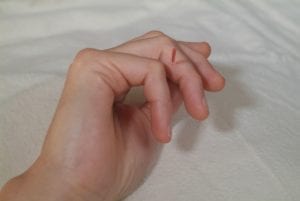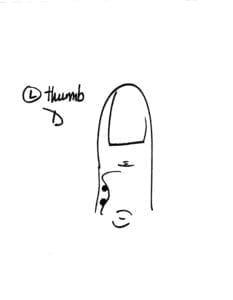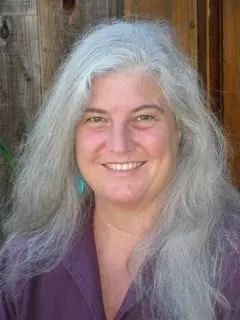By Susan Johnson, LAc, and Eric Renaud, MAc, LAc
Excerpted from: Tung’s Magic Points, Volume One: A Definitive Clinical Guide.
Used primarily for women, 11.06 Return to the Nest and 11.24 Gynecological Points are combined to treat all gynecological diseases, such as premenstrual syndrome, menopausal hot flashes and night sweats, infertility, ovarian disease, cyclic migraines, PCOS, and endometriosis.
11.06 Return to the Nest (Huan Chao)
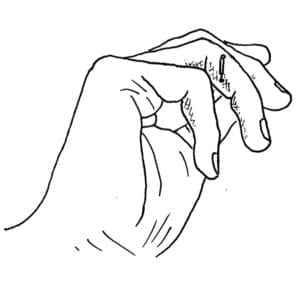
Location:
- This point is located on the ulnar side of the middle phalange of the ring finger, centered between the second and third finger creases, just palmar to the intersection of the red and white skin.
Meridian: San Jiao
Reaction Area: Liver, Kidney
Indications:
- Premenstrual syndrome (PMS)
- Menopausal hot flashes, night sweats, irritability and depression
- Gynecological issues (due to liver qi stagnation)
- Menstrual cramps (dysmenorrhea)
- Excessive or scanty menstrual bleeding
- Infertility
- Blocked fallopian tube (often due to phlegm)
- Habitual miscarriage
- Ovarian disease
- Irregular menses
- Cyclic migraines (may have nausea, vomiting, photophobia)
- Polycystic ovarian syndrome (PCOS)
- Uterine disease
- Liver qi stagnation in the uterus
- Uterine tumors
- Uterine pain following abortion or miscarriage
- Tipped uterus leading to back pain and frequent urination
- Leukorrhea with red or white discharge (if leukorrhea persists for 10 years or more, consider the possibility of cancer)
- Vaginal swelling especially during prolonged labor (with excess liver or high blood pressure)
- Abdominal pain due to reproductive issues
- Yang deficient prostatitis (Liu, 2010)
Needling Notes:
- Needle unilaterally only: It is fine to needle either side (usually combined with 11.24 Gynecological Points on the opposite hand).
- Needle size and gauge: I use a 15mm x 0.16 needle (Japanese 1 gauge or Chinese 40 gauge), inserted just palmar to the intersection of red and white skin in order to avoid immediately striking the side of the phalange. In order to wrap the needle under the bone, I use a curving needle technique, inserting the tip and then introducing a curve in the shaft by holding the handle at a 90-degree angle to the tip. The goal is to insert the needle between the bone and the tendon, as this provides a kidney function by contacting the palmar surface of the bone (bone treats bone) and a liver function (tendon treats tendon). See the demonstration DVD, Master Tung’s Magic Points: Point Location and Needling Technique, for curving needle technique on this point.
- Avoiding blood vessels: It is important to look carefully for blood vessels, as they are frequently found in the area of this point. Vessels may not be obvious, but I have learned an effective way to identify them. Blood vessels beneath the surface cast a shadow, which causes the skin to appear slightly darker than the surrounding area. If we look carefully and choose the more pink or white skin (relatively speaking, considering skin tone), we are far more likely to avoid blood vessels. If the patient feels a sharp burning sensation when Return to the Nest is needled, you have struck a blood vessel. Remove the needle and start again. If you should hit a blood vessel, note its location in your chart so you can avoid it in the future.
- Pegging a tendon: You have pegged a tendon if you see a small depression around the needle where it enters the skin. It will not be particularly sensitive, but the finger will not be able to move at all and the needle will not rotate easily to stimulate the point. If this happens, withdraw the needle until its tip is just under the epidermis and redirect it slightly. Also see “Introduction to needling finger points”.
- Needle stimulation: I often apply strong stimulation to the needle once it is in place, rotating quickly, clockwise and counterclockwise, carefully watching the patient’s eyes for any sign of discomfort (hard blinking). As this point is used to open blocked fallopian tubes and stop menstrual cramps immediately, strong stimulation is required.
- Needle retention: Retain the needle for 45 minutes to one hour or until you recognize that the treatment is complete.
- Combining points for gynecological issues:17 Wood (Anger) is frequently used in combination with Return to the Nest and 11.24 Gynecological Points. When combining these points, first needle 11.17 Wood (Anger) and 11.24 Gynecological Points on the patient’s left hand, followed by 11.06 Return to the Nest on the right hand. This arrangement allows you to best position the patient’s hands after needling, because the Gynecological Points combine better with Wood (Anger) than with Return to the Nest. If you are needling the points multiple times in one week (or even daily in the case of infertility) you can alternate the arrangement by needling Wood (Anger) with Return to the Nest on the patient’s left hand, and needling Gynecological Points on the right hand. We always needle Wood (Anger) on the left side (opposite the liver). Gynecological Points and Return to the Nest can be needled on either hand, and each can be needled unilaterally, but they should never both be needled on the same hand.
- Alternative needling methods: Other Tung’s points practitioners describe needling Return to the Nest by picking up the point at the junction of red and white skin (E-line or A-line), from a dorsal direction. In my opinion, once the finger is relaxed, the location appears the same as in the manner described above. I like using a curving needle technique on Return to the Nest because the kidney governs hormones and bones, and bone treats bone, so by bringing the shaft of the needle into contact with the palmar surface of the bone, we create a strong kidney tonification.
- Depth:3 cun
Are you interested in becoming a certified acupuncture professional?
Visit the links below to explore our specialized acupuncture programs at a campus near you:
Comments:
- 06 combined with 11.24:Unilaterally needled, primarily for women, Return to the Nest is usually combined with 11.24 Gynecological Points to treat all gynecological diseases, as it regulates female hormones. Return to the Nest has a stronger effect on the ovaries, whereas 11.24 Gynecological Points adjusts the qi of the uterus. 11.06 regulates blood (cycles), while 11.24 regulates qi.
- Function: Return to the Nest releases liver qi stagnation, quiets the womb, and calms the fetus. It has a strong tonification and regulatory effect on the kidney, liver and San Jiao.
- Cyclical symptoms: Any symptoms that are cyclic in nature have an ovarian component because the ovaries regulate the menstrual rhythm.
- Dysmenorrhea: 06 relieves dysmenorrhea better than SP6 San Yin Jiao because Return to the Nest prevents acute or chronic cramping from reoccurring. However, SP6 with electrical stimulation is more effective for intense cramping, especially on the first day of the period once full bleeding has commenced. Unfortunately, this powerful effect is only temporary and cannot be implemented prior to menstruation.
- Pregnancy: Return to the Nest quiets the womb and calms the fetus; therefore, it can be used in any kind of pregnancy-related illness. Points that are used to treat infertility are always safe to use during pregnancy. This knowledge is helpful, as the patient may not know when she has conceived.
- Energetic pathways: In the name of this point, “Nest” refers to the womb. Multiple channels affect female reproductive organs, but primarily we think of the liver and kidney channels. Return to the Nest is located on the Hand Shao Yang (SJ) channel and is used to regulate hormones (ovaries) because of the special relationship between the hand Shao Yang (SJ) and the foot Shao Yin (KD). The hand and foot Shao Yang (SJ/GB) connect to the liver through the internal/external relationship between the gallbladder and liver. This makes Return to the Nest effective in the treatment of PMS (irritability and depression), irregular menstrual cycles, dysmenorrhea, cyclic migraines, and any gynecological issue related to the liver and hormonal functions. We can also derive a liver connection through the hand and foot Jue Yin relationship, as the hand Jue Yin (PC) channel splits at PC8 Lao Gong and proceeds to the tips of the middle and ring fingers, connecting with the San Jiao channel through Return to the Nest.
- 06 combined with 11.17 Wood (Anger): Tung’s fantastic points, 11.17 Wood (Anger), are also related to liver and PMS. This is because female reproductive issues such as breast pain, migraines, irritability, depression, dysmenorrhea, fibroid cysts and tumors, and emotional instability due to menopause are often associated with liver imbalance.
- Diagnostic tools: I often use opposite side 66.05 Golden Gate and Return to the Nest as diagnostic tools when there is pain in the lower jiao. Golden Gate usually clears any kind of gastrointestinal discomfort. If it does not relieve the pain, I remove the needle and then needle Return to the Nest with strong stimulation. If there is still no change, the discomfort is likely urinary in origin.
- Tipped uterus: Return to the Nest treats lower back pain due to tipped uterus. The uterus does not tilt without a reason, and usually the cause is multiple fibroids or tumors putting pressure on the bladder and the nerves of the lower back, thus causing frequent urination and lower back pain.
- Yoga pose for retroverted uterus: Retroverted uterus can also be caused by holding the urine too long or not getting enough bed rest after childbirth. When this condition is treated with 11.06 and 11.24, the patient should be asked to do the following exercise (Child’s Pose in Hatha yoga) twice daily, in the morning before arising and at night before going to bed. With an empty bladder, the woman should kneel down, lay her chest on her thighs, and stretch her arms out over her head for a few minutes. This increases the angle of the hips to more than 90 degrees, allowing gravity to help pull the uterus forward (Lee, 1992).
- Uterine pain due to abortion: For uterine pain due to abortion, use only 11.06. In my experience, bilateral needling of SP6 San Yin Jiao only relieves this pain for about 10 minutes. With one needle, Return to the Nest relieves such pain for four to five hours. For uterine pain with pus due to infection, use this point with REN3 Zhong Ji and Zi Gong (Extra Points 3 cun lateral to REN3). Four or five treatments will relieve the pain (Lee, 1992).
- Bleeding technique: Look for blood vessels in the area of SP6 San Yin Jiao, often associated with lower jiao stagnation. Use pricking bleeding techniques to bleed these vessels, and needle 11.06 and 11.24. This bleeding technique is also effective for urinary and lower bowel disorders.
- Neck and shoulder pain: Because Return to the Nest is found on the San Jiao channel, it functions like SJ5 Wai Guan in the treatment of neck, shoulder and upper arm pain. I would never choose it specifically to treat musculoskeletal issues, but the patient might tell you that their pain improved after receiving this point.
- Infertility: If the patient’s little finger does not extend to the crease between the second and third phalange of the ring finger, it is diagnostic for kidney deficiency and is always a sign of infertility (Young, 2008).
11.24 Gynecological Points (Fu Ke)
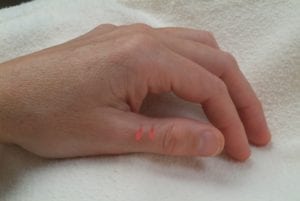
Location:
- This two-point unit is located on the dorsal surface of the thumb, on the ulnar line of the proximal phalange, 0.3 cun lateral to the midline and halfway between the dorsal midline and the junction of red and white skin.
Meridian: Lung
Reaction Area:Uterus
Indications:
- Uterine pain and diseases
- Menstrual irregularity
- Dysmenorrhea
- Amenorrhea
- Menopausal hot flashes, night sweats, irritability and depression
- Endometriosis
- Infertility
- Uterine tumors or fibroids
- Dislocated or tipped uterus
- Uterine pain after abortion
- Uteritis (inflammation of uterus)
Needling Notes:
- Needle unilaterally: Needle perpendicularly from the dorsal surface toward the palmar surface, just inside the heads of the proximal phalange. This appears as a horizontal insertion, with the shaft of the needle passing just beneath the junction of red and white skin; watch for the tip of the needle advancing toward the underside of the epidermis.
- Combining points for gynecological issues: 17 Wood (Anger) is frequently used in combination with Return to the Nest and 11.24 Gynecological Points. When combining these points, we first needle 11.17 Wood (Anger) and 11.24 Gynecological Points on the left hand, followed by 11.06 Return to the Nest on the patient’s right hand. This arrangement allows you to best position the patient’s hands for needling, because the Gynecological Points combine better with Wood (Anger) than with Return to the Nest. If you are needling the points multiple times in one week (or even daily in the case of infertility), you can alternate the arrangement by needling Wood (Anger) with Return to the Nest on the left hand, and needling Gynecological Points on the right hand. We always needle Wood (Anger) on the left side, opposite the liver. Gynecological Points and Return to the Nest can be needled on either hand, and each can be needled unilaterally, but they should never both be needled on the same hand.
- Depth: 3-0.4 cun
Comments:
- Brain connection: These points regulate hormonal activity. Located on the thumb, they have a powerful and direct connection to the brain.
- Qi and blood: The Gynecological Points are for qi; they guide the qi to adjust the uterus. 11.06 Return to the Nest is for blood; it regulates ovarian activity (hormones) and is responsible for regulating cycles. When combined with 11.17 Wood (Anger), the Gynecological Points and Return to the Nest are useful for hormonal imbalances of any kind, including any cyclic ailments, premenstrual or menopausal disorders, migraine headaches, infertility, endometriosis, amenorrhea, irritability, anxiety and depression.
- Tipped uterus: 24 adjusts the qi of the uterus. It is used to treat tipped uterus, which is most often caused by uterine tumors, cysts or fibroids, and is usually accompanied by lower back pain and frequent urination.
- Infertility due to stagnation: Not included in Tung’s system are points called Three Plum Blossom. This three-point unit is located on the abdomen. The first point is 3 cun inferior to the navel; the other two points are found bilaterally, 2 cun inferior to the navel and 2 cun lateral to the midline. When treating infertility, Three Plum Blossom clears uterine stagnation and cleans the womb, treating damp heat conditions such as endometriosis and pelvic inflammatory disease (PID). Three Plum Blossom points are not used after ovulation when patients are trying to conceive. When I am treating a woman for infertility with damp heat accumulation in the uterus, I ask her to use birth control for three months in order to clean and revitalize the womb without any possibility of conception. Bleeding small veins in the area of SP6 San Yin Jiao is also useful for uterine stagnation. The need for cleaning might be characterized by a tongue that is red or coated yellow.
- Infertility due to hormonal imbalance: Many women experience an irregular menstrual cycle due to exhaustion, overwork and cold damp accumulation in the uterus. A white coating or pale tongue with teeth marks indicates damp cold, requiring qi tonification, warming, and clearing dampness.
- Chronic leukorrhea that persists for ten years or more may be indicative of cancer.
Combinations:
- Infertility: 06 Return to the Nest on one side, 11.24 Gynecological Points on the other side (alternate sides daily for two months; stop after conception). Points to strengthen and regulate Spleen, Liver and Kidney: 88.04-88.06 Three Sisters, Three Plum Blossom, 88.09-88.11 Kidney Passing Points and 77.18-77.21 Three Emperors.
- Menopause: 06 Return to the Nest, 11.24 Gynecological Points with 77.18-77.21 Three Emperors. If the patient is emotional, add 11.17 Wood (Anger), Four Gates, Prefrontal Scalp Points, DU20.
- Amenorrhea: 06 Return to the Nest, 11.24 Gynecological Points with ST25 Tian Shu (Yang Ming Mu point), 66.15 Water Fairy (Tung’s KD5), and REN24 Cheng Jiang (Ren Mai – Jing-Well).
- Dysmenorrhea: 06 Return to the Nest, 11.24 Gynecological Points with 66.05 Golden Gate (Tung’s ST43) or ST44 Xian Gu; SP6 San Yin Jiao (needled – with or without electric or pricking bleeding); REN24 Cheng Jiang; 66.02 Wood Wife, 66.03 Fire Hardness.
- Irregular menses: 11.06 Return to the Nest, 24 Gynecological Points, 88.04-88.06 Three Sisters or Three Plum Blossom.
- Promoting conception: 06 Return to the Nest, 11.24 Gynecological Points, Three Plum Blossom (not after ovulation).
- Habitual miscarriage: 06 Return to the Nest on one side, 11.24 Gynecological Points on the other side, 88.10-88.11 Kidney Passing Points.
Susan Johnson, LAc, has been studying acupuncture since 1982. She is an esteemed teacher of Master Tung’s Magic Points, a potent system of acupuncture handed down as a treasured family secret for generations and made public by Master Tung Ching-Chang.
Susan graduated from the American College of Traditional Chinese Medicine in San Francisco, California, was licensed in 1984, and began an internship with Dr. Miriam Lee. She became Dr. Lee’s primary student and trained extensively with her for many years. In 1987, they traveled to Hefei, China, to study bleeding techniques with Dr. Wang Xiu Zhen. Susan studied Master Tung’s Magic Points with both Dr. Lee and Dr. Wei-Chieh Young. During the 1980s she also worked with Dr. Lee, lobbyist Art Krause, and elected officials to pass legislation expanding the scope of acupuncture in California.
Featured Posts:
